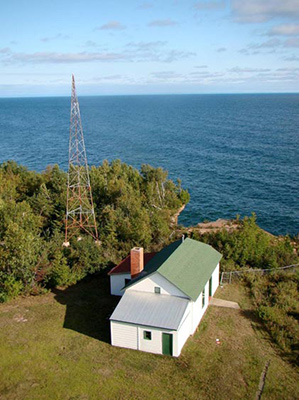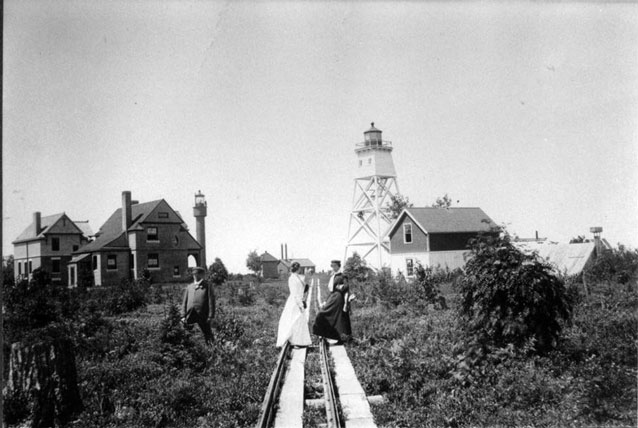The Devils Island Light Station landscape is one of six light stations in Apostle Islands National Lakeshore in Wisconsin. The cultural landscape is a collection of features that remain from its development as a light station over 120 years. It represents changes in maritime navigation and lighthouse engineering and technology in Lake Superior.

NPS
The light station landscape occupies approximately sixteen acres on the north shore of the 318-acre Devils Island, which is situated at the northern edge of the cluster of islands that comprises the park.
The cultural landscape is a collection of features that remain from its development as a light station, including two keeper's dwellings, two hipped-roof brick oil houses, a gable-roofed wooden building housing fog-signal equipment and electrical generators, a pump house, and a small metal truss tower formerly used as a radio tower. The lighthouse complex also includes a boathouse and dock at the south end of the island approximately one mile from the lighthouse, connected to the rest of the complex by a single-lane dirt road. A tramway was built in 1893 to transport goods and fuel around the light station, similar to those built on Michigan and Outer Islands. This was also associated with the 1901 Tramway Engine Building, housing a hoisting engine for the purpose of moving tram carts up and down the inclined tramway.
The Devils Island Light Station was included in a National Register of Historic Places nomination of the Apostle Islands Lighthouses listed in the National Register on March 8, 1977. Five lighthouses were listed with state level of significance in the areas of transportation and commerce and varying periods of significance spanning from 1852 to 1929.
The Devils Island Light Station landscape reflects the culture and lifestyle of the keepers and changing technology associated with navigation, contributing to an understanding of the broader patterns of history related to navigation, shipping, and commerce on Lake Superior. The latest built and farthest north of the archipelago’s light stations, Devils Island Light Station was continuously inhabited from its development in 1891 until its automation in 1978.

NPS / Apostle Islands National Lakeshore Archives
The isolation of the island and its lack of a sheltered harbor resulted in inadequate funding to construct both a satisfactory keeper’s dwelling and a light tower. Thus, the early light signal was operated from a temporary wood frame skeleton tower. Over the next ten years, the Lighthouse Board constructed the fog signal building, three keeper’s dwellings, and finally a permanent steel cylinder light tower that was lit in 1901. In 1909, Devils Island became the first light station equipped with a motorized boat from the Lighthouse Board. In 1939, the United States Coast Guard replaced the United States Bureau of Lighthouses in the management of light stations, and civilian lighthouse keepers were replaced by Coast Guard staff.
Overall, the Devils Island Light Station landscape retains integrity of location, design, setting, materials, workmanship, feeling, and association. Despite minor losses, the buildings and structures at the station generally retain a high degree of integrity and are integral components of the cultural landscape. Spatial organization of the light station landscape has changed significantly due to the expansion of forest vegetation.
Even so, most of the buildings, structures, and features remain in position since the early historic periods. The island is one of the few in the Apostle Islands National Lakeshore not subject to extensive logging. Today, the island is part of the Apostle Islands National Lakeshore operated by the National Park Service, and it continues to serve as an aid to navigation with an automated light tower and radio beacon maintained by the United States Coast Guard.
Quick Facts
- Cultural Landscape Type: Historic Site
- National Register Significance Level: State
- National Register Significance Criteria: A
- Period of Significance: 1895-1959
Landscape Links
Last updated: January 16, 2026
